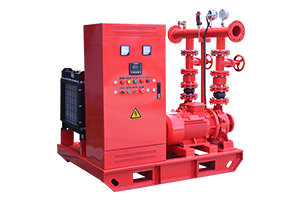How to Improve Fire Pump Performance in High-Rise Buildings?
Dec 03, 2024
Share:
Improving fire pump performance in high-rise buildings is critical to ensure proper water delivery during emergencies. Here are some steps and strategies:

1. Select the Right Fire Pump
- Capacity and Pressure: Choose a fire pump that can meet the building's height and sprinkler system requirements. For high-rise buildings, high-pressure fire pumps or multi-stage pumps are often necessary.
- Type of Pump: Use UL-listed and NFPA 20-compliant fire pumps, such as electric or diesel engine pumps, depending on the building's power availability.
2. Maintain Optimal Installation Standards
- Proper Placement: Install the pump as close to the water supply as possible to minimize friction loss.
- Suction and Discharge Piping: Ensure that the suction pipe has minimal bends, and use the correct pipe diameter to avoid cavitation.
- Jockey Pumps: Include jockey pumps to maintain system pressure and avoid frequent fire pump startups.
3. Ensure a Reliable Water Supply
- Adequate Source: Ensure the water supply is sufficient to handle the maximum system demand for a prolonged period.
- Backup Water Storage: For high-rise buildings, consider dedicated water tanks to guarantee supply during extended emergencies.
4. Incorporate Advanced Control Systems
- Variable Frequency Drive (VFD): Use VFDs to manage motor speed, improving pump efficiency and reducing water hammer issues.
- Pressure Sensors and Alarms: Install sensors to monitor performance and detect issues like low pressure or leaks.
5. Perform Regular Maintenance
- Weekly Testing: Conduct regular churn tests to ensure the pump runs smoothly.
- Inspect Components: Check impellers, seals, bearings, and valves for wear and tear.
- Lubrication: Properly lubricate the pump and motor components to reduce friction and prolong lifespan.
6. Upgrade Piping and Valves
- Pipe Material: Use corrosion-resistant materials, especially for suction and discharge lines.
- Pressure Ratings: Ensure pipes and fittings can handle the required pressure without risk of bursting.
7. Use Booster Pumps for Upper Floors
- Zoning Strategy: Divide the building into zones and install booster pumps for the upper floors to maintain adequate pressure.
8. Adhere to Standards and Testing
- Compliance: Ensure the system complies with local fire safety regulations.
- Flow Testing: Conduct periodic flow tests to confirm that the pump meets the required performance curve.
9. Monitor System Performance
- Remote Monitoring: Use IoT-based systems to track pump performance and identify issues before they escalate.
- Emergency Power Backup: Equip the system with diesel generators or UPS to ensure functionality during power outages.
10. Consult with Experts
- Engage a certified fire protection engineer to design and evaluate the system for high-rise buildings.






